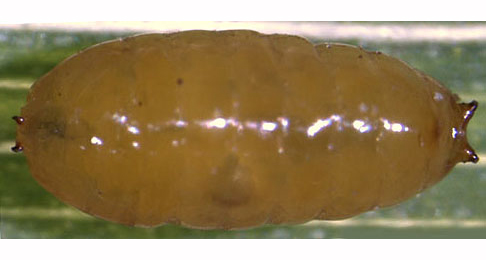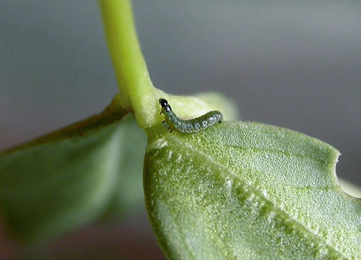|
||||||
|
CORONILLA. Scorpion-vetches. [Fabaceae] |
|
Three introduced species of Coronilla are recorded in Britain. These include Annual Scorpion-vetch (C. scorpioides), Scorpion-vetch (C. coronata) and Shrubby Scorpion-vetch (C. valentina). Seven British miners are recorded on Coronilla. A key to the European miners recorded on Coronilla including Securigera is provided in Bladmineerders van Europa. |
|
Key for the identification of the known mines of British |
1a > Leaf-miner: A short, irregular, linear upper surface mine on any part of the leaf. Also recorded from young pods (Bland, 1997a). Long corridor mine. As a rule the first part of the mine is lower-surface, the later part upper-surface. Often the loops are so dense that a secondary blotch is the result. Because upper- and lower-surface corridor segments often cross, the mine obtains a strange array of transparant patches. There is no association with the midrib. Frass in strings and thread fragments. Pupation outside the mine; exit slit in upper epidermis. Mine not associated with the veins or midrib of the leaf (It is this character which enables distinction from another Agromyzid pest species - Liriomyza huidobriensis). The larvae may leave one leaf (if not large enough) and enter another leaf, via the petiole). It exits the leaf to pupate through a semi-circular slit in the upper surface of the leaf. |
|
Liriomyza bryoniae (Kaltenbach, 1858) [Diptera: Agromyzidae]. |
1b > Leaf-miner: An upper or lower surface shallow winding linear mine, which may develop into a secondary blotch. Pupation external (Spencer, 1976: 240). Puparium orange Upper- or lower-surface, greenish or whitish corridor, sometimes a blotch. The corridor does not widen much and is not associated with the midrib. Frass in conspicuous thread fragments, alternating along the sides of the corridor. Pupation outside the mine. The mine is also illustrated in British Leafminers. |
|
Liriomyza cicerina (Rondani, 1975) [Diptera: Agromyzidae]. |
1c > Leaf-miner: Corridor leaf-mine in leaves. An upper surface linear mine with frass in conspicuous greenish strips, largely alternating at each side of the channel (Spencer, 1976: 241). Upper-surface, unbranched corridor, relatively broad from the start on, but only weakly widening subsequently. The fresh mine is bright green, but turns whitish, later brown, quickly. Frass in a wide green band in the centre of the corridor, with small black granules at either side. Pupation outside the mine. Forms an upper surface mine, with the frass in a green strips. |
 Liriomyza congesta puparium Image: © Willem Ellis (Bladmineerders van Europa) |
|
Liriomyza congesta (Becker, 1903) [Diptera: Agromyzidae]. |
1d > Leaf-miner: A narrow linear mine adjoining the leaf margin in the first instar, which later develops into an irregular blotch with conspicuous lumps of greenish frass (Spencer, 1976: 302). The first instar larva makes a narrow upper-surface corridor along the leaf margin. After it has moulted it begins a large upper-surface blotch. Frass in conspicuous green lumps, that can run out irregularly. Pupation outside the mine. Forms a narrow linear mine by the margin of the leaf which later develops into a blotch. The blotch has clumps of greenish frass. |
|
Phytoliriomyza variegata (Meigen, 1830) [Diptera: Agromyzidae]. |
1e > Leaf miner: The first generation initially forms an unmistakable leaf-mine on Anthyllis vulneraria, but the second generation feeds on the flowers. Feeding signs on other plants vary in appearance. Larvae can move between sewn leaves, and more than one larva may be found together. Larvae in a small full depth blotch, often with extensions. Frass concentrated in one corner of the mine. The mining activities may cause the leaf to roll inwards. Older larvae live free among spun leaves, but still they may make then full depth mines by feeding on the leaf tissue from a small opening. |
 Aproaerema anthyllidella larva, dorsal Image: © Steve Wullaert (Bladmineerders van Europa) |
| On Anthyllis, Medicago, Onobrychis, Ononis and Trifolium, but not yet on Coronilla, in Britain and Anthyllis, Chamaecytisus, Coronilla, Cysisus, Dorycnium, Galega, Glycine, Hymenocarpos, Lathyrus, Lotus, Medicago, Melilotus, Onobrychis, Ononis, Ornithopus, Oxytropis, Phaseolus, Psoralea, Trifolium, Trigonella and Vicia elsewhere. Britain including the Channel Is. and Northern Ireland. Also recorded in the Republic of Ireland. Widespread in continental Europe. |
Aproaerema anthyllidella (Hübner, 1813) [Lepidoptera: Gelechiidae]. |
1f > Leaf miner: The frass is arranged in a spiral and a circular blotch is formed. Egg at the underside of the leaf. The mine is an upper-surface blotch without anything like a preceding corridor. The blotch is about circular, but my have broad lobes. Black frass grains lie in indistinct arcs or spirals, glued to the upper epidermis, and forming a cark central patch. The larva can leave a mined leaf, and restart elsewhere. Pupation external. Cocoon spun beneath the leaf. |
|
Leucoptera lotella (Stainton, 1859) [Lepidoptera: Lyonetiidae]. |
1g > Leaf miner: An initial gallery, which usually follows the leaf margin. Then forms a blotch, mining from the leaf base to the tip. The presence of a pupa in the mine is unusual for this species and may indicate parasitism. Oviposition on the leaf underside. The mine begins as a long corridor with a very broad, green frass line. This corridor suddenly widens into a broad blotch, that in the end may occupy almost an entire leaflet. The blotch generally begins in the leaf base, and it is here that most frass is concentrated. Shortly before pupation the larva leaves its mine through an exit slit in the lower epidermis. After the mine has been vacated the leaflet drops off. |
|
Trifurcula cryptella (Stainton, 1856) [Lepidoptera: Nepticulidae]. |
| Last updated 02-Jul-2019 Brian Pitkin | ||
